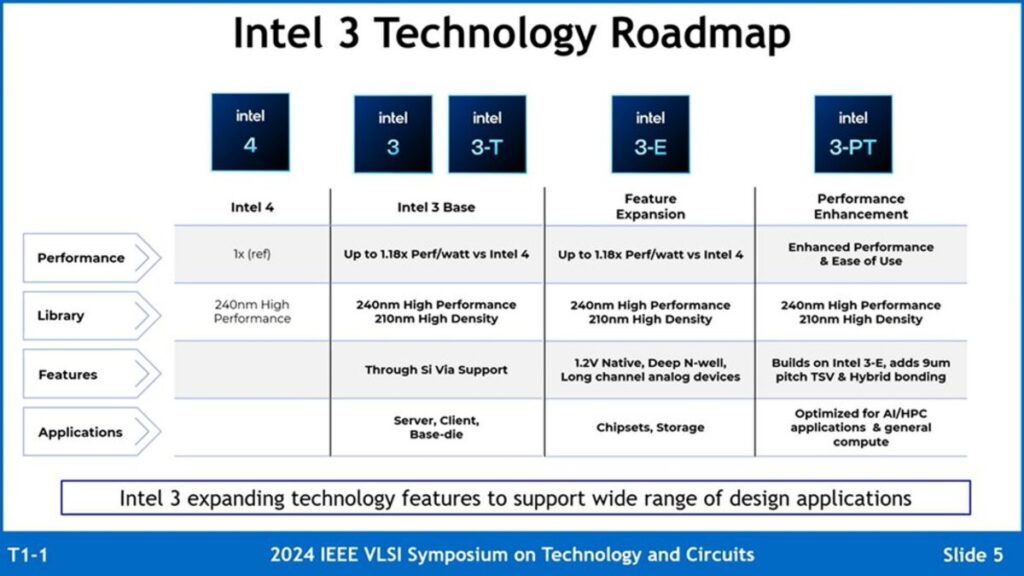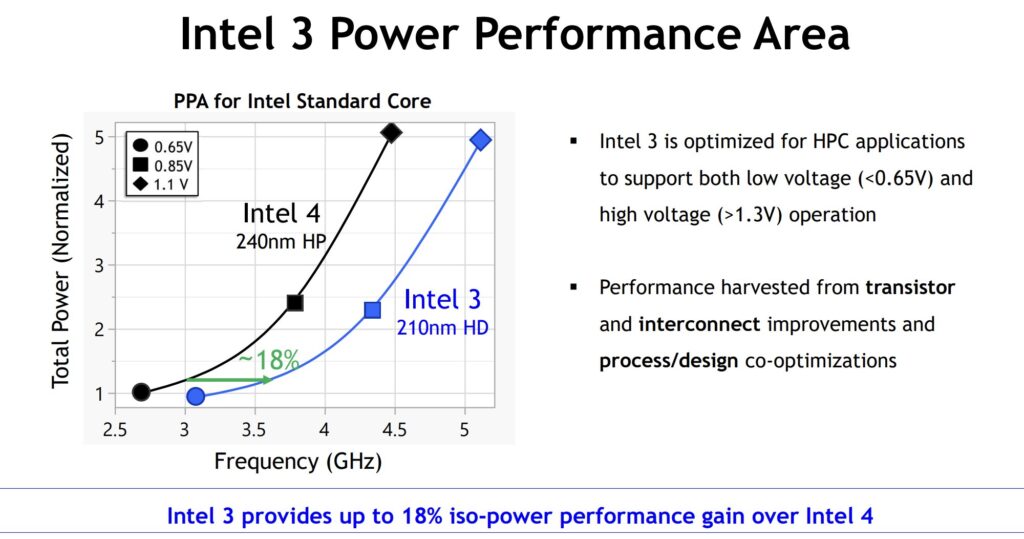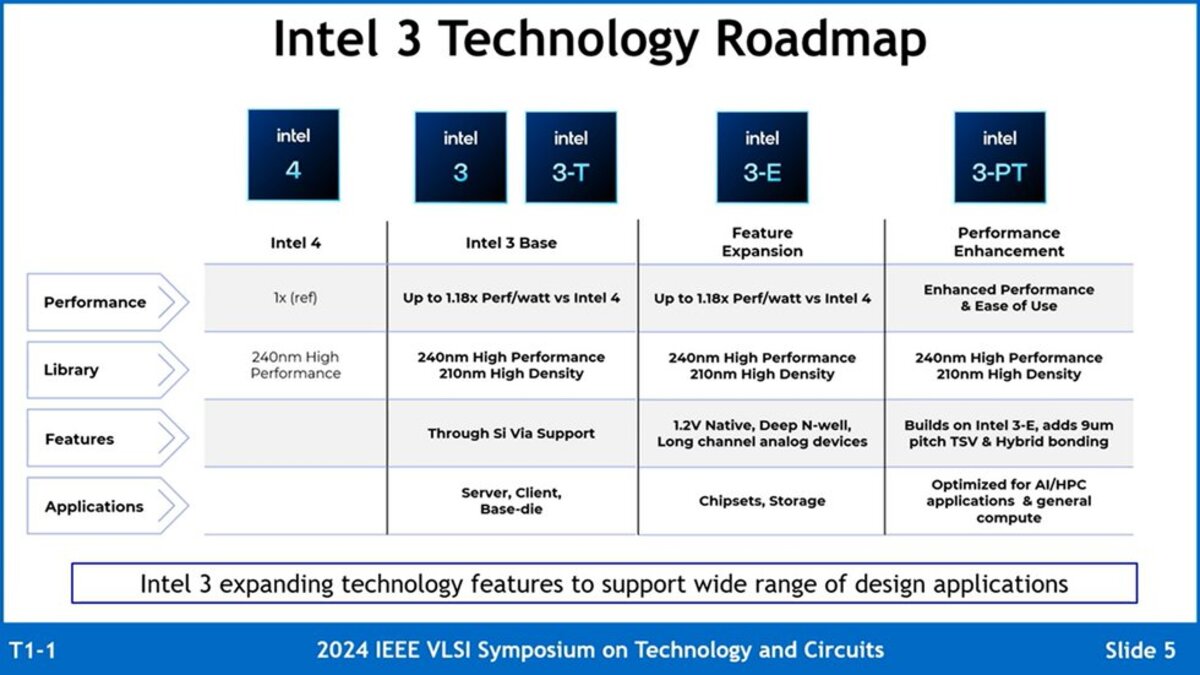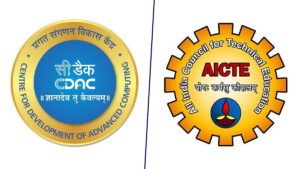Itroduction
The Intel 3 Technology Roadmap, presented at the 2024 IEEE VLSI Symposium on Technology and Circuits, outlines Intel’s strategic advancements and goals in semiconductor technology.
This roadmap highlights the evolution from Intel 4 to the various iterations of Intel 3, showcasing the enhancements in performance, library, features, and applications.
Let’s delve into the specifics of each segment of this roadmap and understand its implications for the future of semiconductor technology.

Image Credits: Intel
Intel 4 to Intel 3 Transition
Performance
The performance metric starts with Intel 4, serving as the reference point (1x ref). Moving to Intel 3, we see an improvement with up to 1.18x performance per watt compared to Intel 4. This enhancement indicates Intel’s commitment to increasing efficiency while maintaining high performance.
Library
For the library specifications, Intel 4 utilizes a 240nm high-performance process. Intel 3 continues with this standard but introduces a higher density option at 210nm, which allows for more compact and efficient chip designs.
Features
Intel 3 introduces several new features:
- Through-Si Via (TSV) Support: This feature is present in the base version of Intel 3, indicating enhanced interconnect capabilities that can lead to better performance and power efficiency.
- 1.2V Native, Deep N-well, Long Channel Analog Devices: This expansion in Intel 3-E includes improved analog device integration, beneficial for applications requiring precise analog performance such as chipsets and storage solutions.
- 9μm Pitch TSV & Hybrid Bonding: Intel 3-PT builds upon Intel 3-E by adding advanced TSV and hybrid bonding technologies, further optimizing the performance for AI/HPC applications and general compute tasks.
Read More: Top 5 Machine Learning Libraries for Every Project – techovedas
Applications
The applications for these technologies vary across the roadmap:
- Intel 4: Primarily focused on high-performance applications.
- Intel 3 Base: Targeted towards servers, clients, and base-die applications, leveraging improved performance and density.
- Intel 3-3T and Intel 3-E: Suitable for chipsets and storage, benefiting from feature expansions.
- Intel 3-PT: Optimized for AI/HPC applications and general compute, indicating a broader and more robust use case scenario.
Read More: Follow us on Linkedin for everything around Semiconductors & AI

Image Credits: Intel
Detailed Breakdown of Intel 3 Variants
Base
- Performance: Up to 1.18x performance per watt vs Intel 4.
- Library: 240nm high performance and 210nm high density.
- Features: TSV support for enhanced interconnectivity.
- Applications: Focus on server, client, and base-die applications.
Intel 3-3T
- Performance: Maintains the same performance enhancements as the base.
- Library: Consistent with Intel 3 base.
- Features: Builds on TSV support, likely indicating additional improvements in interconnect technology.
- Applications: Extends the application range of Intel 3 base.
3-E (Feature Expansion)
- Performance: Up to 1.18x performance per watt vs Intel 4.
- Library: 240nm high performance and 210nm high density.
- Features: Adds 1.2V native, deep N-well, and long channel analog devices for better analog performance.
- Applications: Chipsets and storage, emphasizing reliability and performance in these areas.
Intel 3-PT (Performance Enhancement)
- Performance: Enhanced performance and ease of use.
- Library: 240nm high performance and 210nm high density.
- Features: Builds on Intel 3-E features with 9μm pitch TSV and hybrid bonding.
- Applications: Optimized for AI/HPC applications and general compute, highlighting Intel’s focus on cutting-edge technology sectors.
Read More:Samsung to Introduce New 3D Packaging SAINT: HBM Goes Vertical – techovedas
Conclusion
The Intel 3 Technology Roadmap demonstrates Intel’s strategic enhancements across various facets of semiconductor technology, from performance improvements to advanced features and broader application scopes.
Each iteration of Intel 3 builds on the previous, introducing new technologies and optimizations aimed at meeting the demands of modern high-performance computing, AI, and general-purpose applications.
As Intel continues to innovate, these advancements will play a crucial role in shaping the future of the semiconductor industry and maintaining Intel’s competitive edge.








